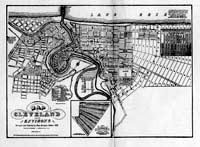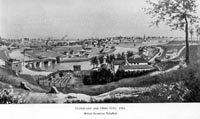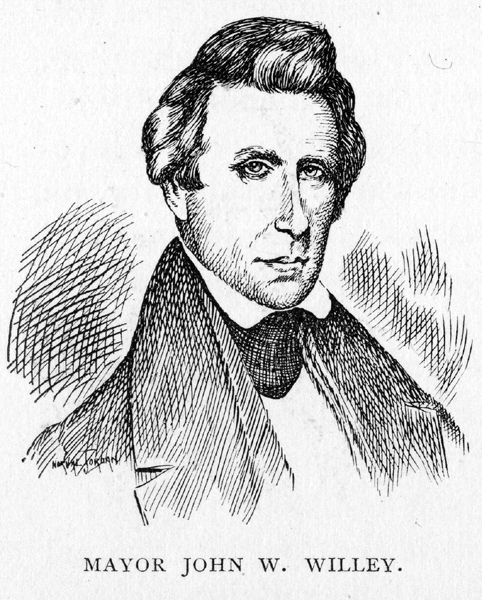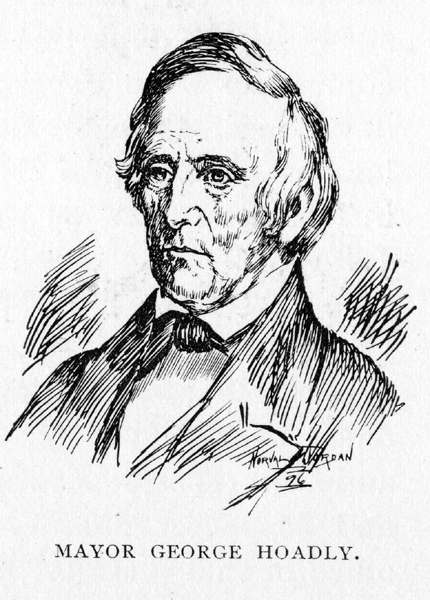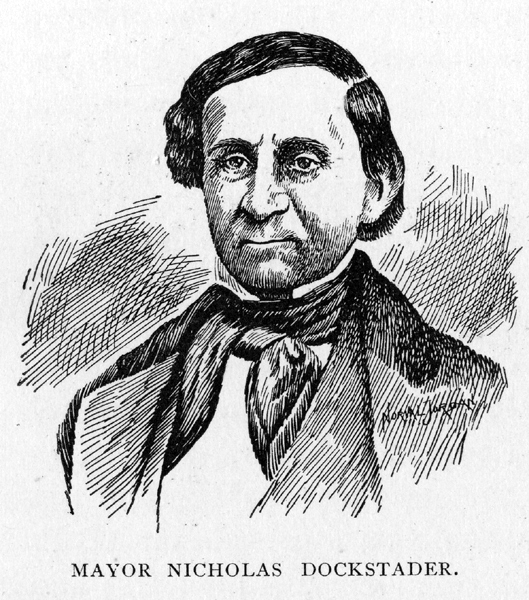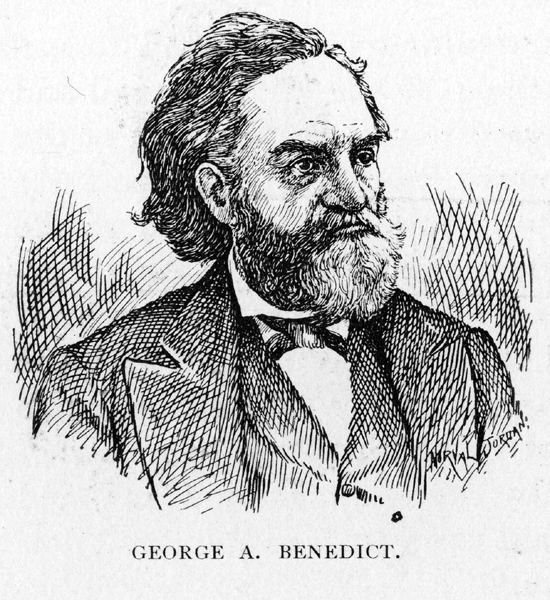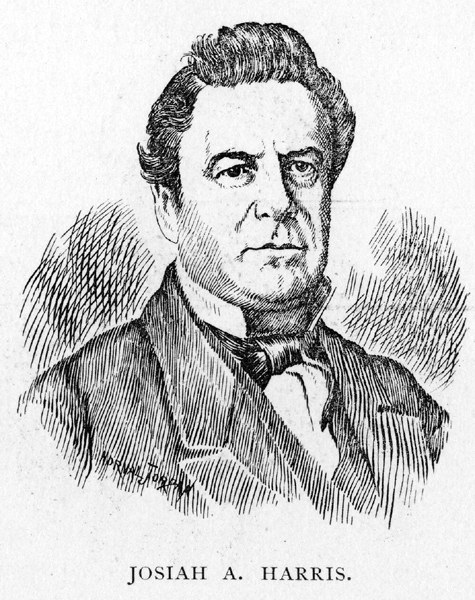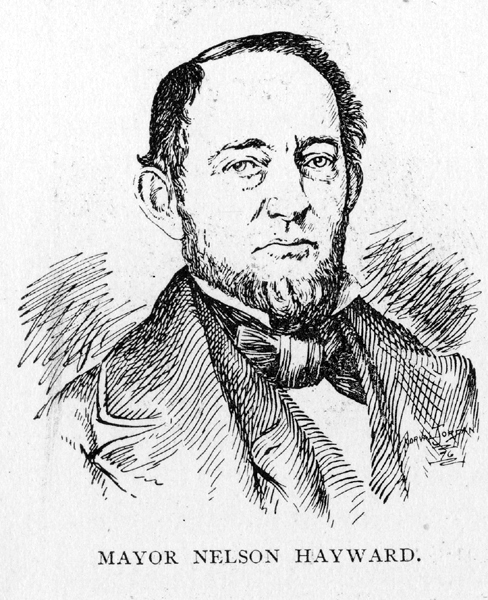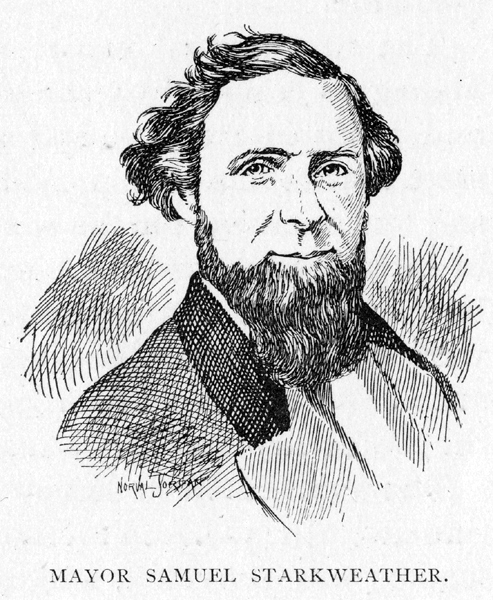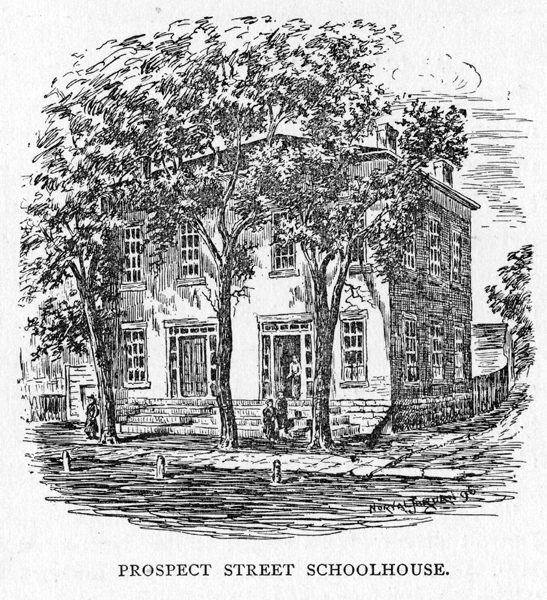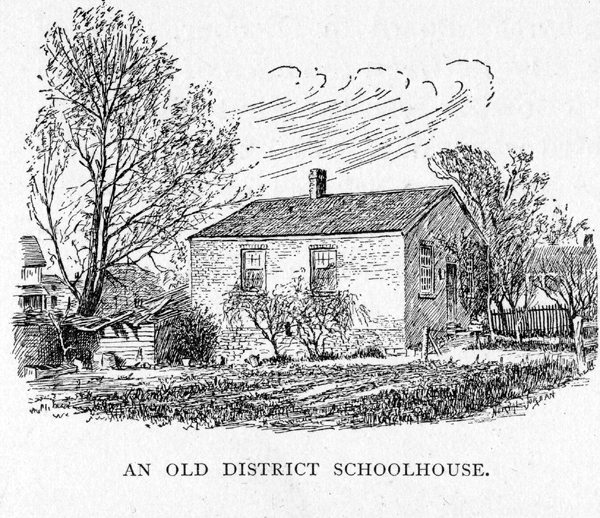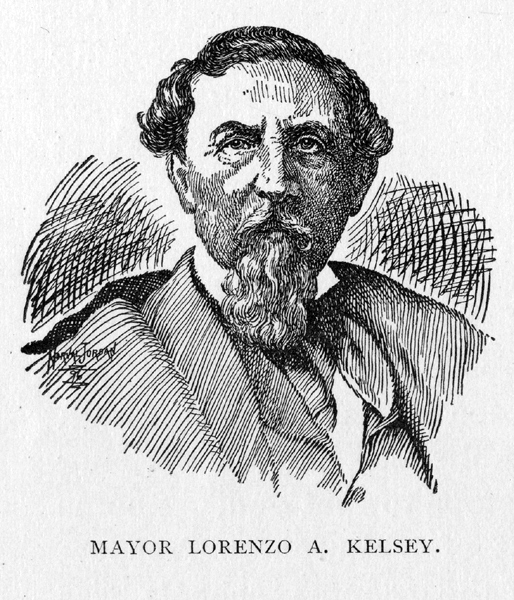|
CHAPTER XI THE CITY OF CLEVELAND. The era of railroad building, that was inaugurated in America with such wide-spread results, in the decade from 1830 to 1840, brought Cleveland, for the first time, within its direct influence in the early days of 1834. On the 3rd of March, of that year, an act was passed by the Ohio Legislature incorporating an organization by "the name and style of the Cleveland and Newburgh Railroad Company." Those named in the act as corporators were Aaron Barker, David H. Beardsley, Truman P. Handy, John W. Allen, Horace Perry, Lyman Kendall, and James S. Clark. They were authorized to construct a railroad "from some point in lot No. 413 in Newburgh township, to the harbor in Cleveland; "permitted to transport freight and passengers "by the power and force of steam, animals, or other mechanical force, or by a combination of them." Their terminus, at the eastern end, was near a stone quarry on the lot named, which was itself near the corner of the four townships�Cleveland, Euclid, Warrensville and Newburg. There was, immediately, a scene of activity in that neighborhood, as the expectations of the American people as to what could be accomplished by aid of a railroad, even though run by horse-power, were very great. A depot was put up, and the farm lands, lying around about, were cut up into building lots. The authorized stock was fifty thousand dollars, which was subscribed, and construction commenced. Ahaz Merchant was chief engineer. The track was laid through Euclid street, and across Doan Brook, and thence on up to the quarry, near where Adelbert College now stands. The rails were made of wood, and two horses driven tandem constituted the motive power. The line ran along the south side of the Public Square, while the depot was a part of the barn of the Cleveland Hotel, which stood upon the present site of the Forest City House. The Square was, at that time, the dumping ground of the stone brought in. This first "railroad" of Cleveland was operated only for a few years and then abandoned, the rotting ties and rails remaining for a long time a public nuisance upon the highway.164 There was a quiet but steady growth all through 1834, but nothing of a startling nature to chronicle. The Cuyahoga Steam Furnace Company was organized in that year, the chief stockholders being Josiah Barber, Richard Lord, Luke Risley and Charles Hoyt. The plant was located at the corner of Detroit and Center streets, and for many years it was the chief iron manufacturing concern of the city. The first locomotive made west of the Alleghanies was manufactured there , and also the machinery for the first screw propeller to run upon the lakes. In 1841, the company manufactured a large number of cannon for the United Sta5tes Government, and at a later date enlarged its scope of operations for the making of plows, castings, mill-irons, etc. The locomotive above referred to was made for a newly-constructed railway between Detroit and Pontiac, Michigan, and after twelve years of use, was in such good condition that it was sold for nearly its first cost. At these works were also built the locomotives first used on the Cleveland, Columbus & Cincinnati Railroad, and also those on the Cleveland & Ashtabula. Another venture for the year 1834 was the establish- ment of yet another newspaper, the Cleveland "Whig." We have seen how the "Herald" came into being, and also, noted the birth and death of its short-lived predecessor, the "Gazette and Commercial Register." From 1819 to 1832, the "Herald" seems to have held the field without a rival. In the year last named, it veered somewhat toward Democracy, or "Jacksonianism." as it was called at a time when Andrew Jackson dominated his party. The Cleveland Whigs were naturally not pleased with this course, and a number of them set to work for the creation of a counteracting agency. Madison Kelley was persuaded to undertake the task, and in 1832 established the "Advertiser," as an out-and-out Whig organ. John W. Allen wrote the first editorial, and the party back of the venture were pleased with the tone of their new defender; and yet such is the irony of fate, that out of this Whig organ grew that staunch Democratic newspaper, the Cleveland "Plain Dealer," while the "Herald" finally came around to the support of the Whigs. The "Advertiser" was sold in 1834 to Canfield & Spencer, who continued its publication as a Democratic weekly paper until 1836, when it became a daily. J. W. and A. N. Gray purchased it in 1841, and changed the name to the "Plain Dealer," by which name it has been known since. The "Whig," which appeared on the 20th of August (1834), was published by Rice & Penniman, and existed about two years. During several succeeding years, the ambition of various parties took the direction of newspapers, and the little city�for such it was soon called�suffered no dearth of periodical literature. In 1836, came the "Messenger," which died within a year; and in the same year the "Ohio City Argus" was established on the West Side, by T. H. Smead and Lyman W. Hall�quite Whiggish in its tendencies, but not very partisan. Col. Charles Whittlesey established the "Cleveland Daily Gazette" in 1836, which united with the "Herald" in 1837, under the name "Daily Herald and Gazette." "The Liberalist" came in 1836, and was so skeptical in it tendencies Facing Page That it failed of support, and died within a year. The "Journal" came into existence in 1836; the "Commercial Intelligencer" in 1838; the "Axe" in 1840; the "Agitator" in 1840; the "Morning News," the "Palladium of Liberty," the "Eagle-Eyed News-Catcher," and the "Morning Mercury," were the products of 1841, and, during several succeeding years, other like attempts were made, only to be overtaken by the same fate. Three churches were added to the growing religious and moral agencies of Cleveland in 1834. St. John�s Episcopal, on the West Side, was organized in this year, and held services in school-houses and in the residences of its members until 1836, when a commodious stone church building was erected on the corner of Church and Wall streets. The First Congregational Church was also organized on December 21st, with a membership of thirty-eight. There were at this time but fifteen German families in Cleveland. A meeting of several of these was held, where they organized the German Evangelical Protestant Church society. The early meetings were held in the old Bethel building, between Water street and Superior street hill, until 1836, when the society moved to what was known as the Third Ward School, on St. Clair street. The name of Henry B. Payne165 first appears on the public records of Cleveland in 1834, when he served as a clerk of elections. He had become a resident of Cleveland the previous year, and formed a law partnership with H. V. Willson, his former class-mate. The long and valuable connection of Mr. Payne with Cleveland, and her public interests, will be shown, from time to time, in the record that follows. There was commenced in the office of the clerk of Cuyahoga County, on September 26th, 1834, a record book which the law compelled, but which reads now with little credit to the law-makers of Ohio. It is still in existence, in the dusty files of that office, although, let us say thankfully, the use for it has long since passed away. Upon the first page is this entry: "Record of Black and Mulatto person, certificates of freedom, bonds, etc.: It was commenced in accordance with the requirements of an act of the Ohio Legislature of 1804, which provided that "no black or mulatto person shall be permitted to settle or reside in this State unless he or she shall first procure a fair certificate from some court within the United States of his or her actual freedom, and requiring every such person to have such certificate recorded in the clerk�s office in the county in which he or she intended to reside." The law further provided that it should be unlawful, and punishable with a fine, to employ any such person not provided with a certificate of this character. Another act was passed in the same year, making it punishable with a fine to harbor or secrete any "black or mulatto person," and also imposing a fine of one thousand dollars upon anyone who aided or assisted in the removal of any such person�"The property of another," In 1807, a law as to slaves was enacted to the effect that no negro or mulatto should be permitted to settle within the State, unless such person should, twenty days thereafter, enter into a bond, with two or more freehold sureties, "conditioned for the good behavior of such negro or mulatto, and to pay for the support of such person in case he or Facing Page she be found within any township unable to support him or herself." The first entry in this book, as above stated, was made in 1834, and the last one appears in 1851. One Thornton Kinney, in one of the earliest registrations, was described as "a man of dark complexion, age twenty-one years, five feet nine inches high, and was free born." Another is that of "Jesse Burrell, about forty-nine years of age; has a scar on the forehead, and one over the left eye." This bears the attestation of Robert F. Paine, clerk, by William Waterman, deputy. Public opinion upon the question of slave-holding was very much divided in Ohio, even at that late date, the general view being that it was a necessary social and political institution for the South, and that it was the duty of the North to protect, so far as in their power lay, the slave-holders in the possession of their human chattels. It will hardly be necessary to apologize for yet another digression at this point, for the purpose of taking a personal view of Cleveland in this year 1835, through the eyes of one who was then a sturdy boy, and now an honored jurist and useful citizen�Hon. James D. Cleveland.166 "As the steamer came up the river," writes Judge Cleveland, "the boy read the signs on the warehouses�Richard Winslow, Blair & Smith, Foster & Denison, W. V. Craw, Robert H. Backus, Tillett & Hickox, C. M. Giddings, N. M. Standart, M. B. Scott, Griffith & Standart, Noble H. Merwin�and passed scores of steamers, schooners and canal boats, exchanging wheat and flour from interior Ohio for goods and salt to be carried to the canal towns all the way to the Ohio River. Walking up Superior lane, a steep, unpaved road, you passed the stores of Denker & Borges; Deacon Whitaker�s, full of stoves; George Worthington, hardware; at the corner of Union lane, where Captain McCurdy had lately retired from the dry good business; Strickland & Gaylord, drugs, etc.; Stanford & Lott, printing and book-store; and T. W. Morse, tailor. On reaching the top, Superior street, 132 feet wide, spread before you�the widest of unpaved streets, with not a foot of flagged sidewalk except at the corner of Bank street, in front of a bank. It was lined with a few brick, two and three-story buildings. A town pump stood at the corner of Bank street, near the old Commercial Bank of Lake Erie, on the corner, of which Leonard Case was president, and Truman P. Hand cashier. There were three or four hotels. Pigs ran in the street, and many a cow browsed on all the approaches to it. Dr. Long had a fine two-story residence on the corner of Seneca street. Mr. Case, C. M. Giddings, Elijah Bingham, William Lemon, John W. Allen, and a few others, had residences dotted around the Public Square, upon which the old Stone Church occupied its present site, and in the southwest corner stood the court-house. The post-office occupied a little ten by fifty feet store-room in Levi Johnson�s building, below Bank street, and you received your letters from the hands of Postmaster Daniel Worley, and paid him the eighteen pence, or twenty-five cents postage, to which it was subject, according to the distance it had travelled. The great majority of the best residences were on Water, St. Clair and Lake streets. A few good houses had been built on Euclid avenue, but the Virginia rail-fence still lined it on the north side, from where Bond street now is to the Jones residence, near Erie street, where Judge Jones and the Senator (John P. Jones) lived in their boyhood. There were groves of fine black oaks and chestnuts on Erie street between Superior and Prospect streets, and a good many on the northeast part of the Public Square, and between St. Clair street and the lake. With its scattered houses, its numerous groves, its lofty outlook upon the lake, its clear atmosphere, as yet unpolluted by smoke, Cleveland was as beautiful a village as could be found west of New Haven." The ship-building interests of the city received a marked impetus, when, in 1835, Seth W. Johnson opened a yard, at first confining himself to the repairing of vessels. He soon turned his attention to building, and the steam-boats "Constellation" and "Robert Fulton" were among the first of his works. The establishment was increased, in 1844, by the addition of Mr. Tisdale, and the firm name became Johnson & Tisdale. This copartnership lasted nineteen years. The firm of Quayle & Moses built a number of vessels; when Mr. Moses retired, John Martin took his place, the firm living for a long time in local history as Quayle & Martin. From the time of this connection up to 1869 they had built fully seventy-five vessels, and in one year they turned out thirteen. E. M. Peck opened a yard here, his first ship being the "Jenny Lind," of two hundred tons. He formed a partnership, in 1855, with L. U. Masters, under the name of Peck & Masters, which existed until 1864. Over fifty vessels were launched by them, and after the dissolution of the firm, Mr. Peck carried on the business alone. He built the revenue cutters "John Sherman" and "A. P. Fessenden," which were prompty accepted by the government, and put in commission on the great lakes. He also constructed a number of other vessels, the greater part of them being of large size. Captain Alva Bradley removed his shipyard from Vermillion to Cleveland in 1868, and built many vessels here before retiring from the ship-building business. In 1853, the vessel building interest of Cleveland took a new start, and made rapid and wonderful progress. In 1856, a total of thirty-seven craft was reported, having a tonnage of nearly sixteen thousand. This important industry not only held its own afterwards, but soon grew into a great and remarkable place in the commercial development of Cleveland. Between 1849 and 1869, nearly five hundred vessels of all kinds, for lake navigation, were built in the district of Cuyahoga, nearly all of which were the production of Cleveland ship-yards. The records of the Board of Trade gave the total registered tonnage in 1884 at 84,295 tons. Carrying this marine record back to 1835, the year now under consideration, we note an increased activity along the lake front, as an unwonted emigration to the west had set in. Cleveland had at that time a population of 5,080, and was daily receiving additions. "Steamers ran from Buffalo to Detroit," says one Chronicle,167 "crowded with passengers, at a fare of eight dollars, the number on board of what would now be called small boats reaching from five to six hundred persons. The line hired steamers and fined them a hundred dollars if the round trip was not made in eight days. The slower boats, not being able to make that time, with any certainly, frequently stopped at Cleveland, discharged their passengers, and put back to Buffalo. It, sometimes, chanced that the shore accommodations were insufficient for the great crown of emigrants stopping over t this point, and the steamers were hired to lie off the port all night that the passengers might have sleeping accommodations." From March 15th to November 28th, in the year following (1836), nineteen hundred and one vessels of various kinds arrived in this port, which is certainly a large gain since 1818, when the "Walk-in-the-Water" hade her first appearance here. There was a reason for this sudden tax upon the hospitality of the Cleveland hotels, and this increased number of visitors. The spirit of speculation in land was moving men in an unusual degree, and towns and cities upon paper were springing up in all directions. There was a great rush toward the already-opened but undeveloped sections of the west. Lines of emigrant wagons were seen almost daily, and the means of transportation by lake and canal were severely taxed. This boom, as it would now be called, had struck the Cuyahoga Valley, and the impression, suddenly came into the minds of Clevelanders that their village had been touched at last by the wand of destiny, and that all the possibilities of a great future lay within her reach. This was, in a sense, set in the way of realization, when, in 1836, Cleveland took upon herself the dignity and responsibilities of an incorporated city. In expectation of this important step, and in an extension of the opportunities for settlement, a number of allotments in the outlying districts had been made. On January 12th, 1833, Alfred Kelley had made an allotment of the section lying west of Water street, and immediately south of Bath street. Toward the end of the same year, James S. Clark, Edmund Clark and Richard Hilliard made what was called "the Center Allotment," embracing all of the land in the first bend of the river. In April, 1834, Leonard Case laid out a ten-acre lot, at the southeast corner of the old city plat, and widened the Newburg road (Broadway), from 66 to 99 feet, to correspond with the original Ontario street. John M. Woolsey, in 1834, also added to the lands upon the market, by an allotment of all the two-acre lots south of Superior street and west of Erie street. Lee Canfield, Sheldon Pease and their associates, in November, 1835, allotted the two-acre lots at the northeast corner of the city plat, and laid out and dedicated Clinton Park. In January, 1836, Thomas Kelley and Ashbel W. Walworth laid out the two-acre lots south of Ohio street, and also a large tract of land adjoining the same, and reaching to the river. Preparations of the same active nature were being carried on, with an equal vigor, upon the other side of the river, where there was also a firm belief that manifest destiny foreshadowed important things. We have seen, already, how various enterprising capitalists had, in 1833, purchased a tract of some eighty acres, and laid it out into lots and streets, and known in the local comment and discussion of the day as "the Buffalo Company Purchase," Several allotments had also been made, outside f this section, by various parties owning lands in that vicinity. Among the members of the Buffalo Land Company were Philander Bennett, Major A. Andrews, Thomas Sheldon, N. C. Baldwin, B. F. Tyler, and Charles Winslow. The purpose the founders of the organization had in mind, was to drain and to improve the lands, locate factories and dwellings, and make that section the chief point upon the Cuyahoga River. Naturally, there was a great deal of rivalry between the two villages, and this feeling culminated, early in 1836, in a contest, as to which should be the first to don full municipal honors. A bill was also introduced, in the same body, for the incorporation of "The City of Ohio,"168 upon the other side of the river. It contained a clause that officers should be elected on the third Monday in March. The bill passed on March 3rd, just two days before that incorporating Cleveland became a law, which was on March 5th, 1836. Thus the west side of the river, both in the date of the law and of the first election, became a full-fledged city before her older neighbor across the Cuyahoga River. The law described the territory to be embraced within the limits of this new-made city, and declared that "the inhabitants thereof" were created "a body corporate and politic, by the name and style of the City of Cleveland." The limits laid down were as follows: "Beginning at low water mark on the shore of Lake Erie at the most northeastwardly corner of Cleveland, ten-acre lot number one hundred and thirty-nine, and running thence on the dividing line between lots number one hun- dred and thirty-nine and one hundred and forty, numbers one hundred and seven and one hundred and eight, numbers eighty and eighty-one, numbers fifty-five and fifty-six, numbers thirty-one and thirty-two, and numbers six and seven of the ten-acre lots to the south line of the ten-acre lots, thence on the south line of the ten-acre lots to the Cuyahoga River, thence down the same to the extreme point of the west pier of the harbor, thence to the township line between Brooklyn and Cleveland, thence on that line northwardly to the county line, thence eastwardly with said line to a point due north of the place of beginning, thence south to the place of beginning." The final meeting of the trustees of the incorporated Village of Cleveland, was held on the 21st of March, 1836, when it was ordered that the election to choose city officers "under the charter incorporating the City of Cleveland be held in the several (three) wards in said city, on the second Monday of April, 1836." The judges and clerks of said election were appointed, as follows: First ward: Judges, Richard Winslow, Seth A. Abbey, Edward Clark. Clerks, Thomas Bolton, Henry H. Dodge. It was ordered also that the election in the first ward should be held in the Court-House; that of the second ward in the lower room of the Stone Church; and that of the third ward at the Academy. While these places were, of course, chosen because of locality and room, it will be noted that the new-born city started off well, holding its first election, as it were, within the visible portals of the law, the gospel, and education. The election was held in due season, with the following result: Mayor: John W. Willey.
John W. Willey, who was then entrusted with the honor and responsibility of serving as the first mayor of Cleveland, was qualified in all ways for that position. He was of New Hampshire birth, and was twenty-five years of age, when, in 1822, he settled in Cleveland, and began the practice of law. He was thoroughly fitted to make his way in a new and growing country. Well learned in the law, of a keen and penetrating mind, a logician by nature, and endowed with great eloquence and wit, he soon became a marked figure at the Ohio bar. He served three years as representative and three as senator in the general assembly of Ohio. On his election as mayor of Cleveland he gave himself earnestly to the peculiar demands of a formative period, paying much attention to the preparation of the laws under which the new city commenced its official life. He was re-elected mayor, in 1837, by a large majority. In 1840, he was appointed to the bench of the common pleas court of Cuyahoga County, which he was eminently fitted to adorn. At the time of his death, which occurred in June, 1841, he was president judge of the fourteenth judicial district. Of the quality of Judge Willey�s work for the city, Judge Griswold speaks as follows in the address heretofore quoted: "The act by which the city was incorporated is a most excellently drafter instrument. It shows, on the part of its author, a clear understanding of the municipal rights and duties. The language is clear and precise, and throughout its whole length it bears the impress of an educated, experienced legal mind. It was, undoubtedly, the work of the first mayor, and, I may add, for the purpose of furnishing the basis of wise city legislation for clearness, precision, and certainty, it will not suffer by comparison with any of the municopal codes enacted since the adoption of th present constitution."
The first meeting of the first City Council of Cleveland, was held in the Court-House on April 15th, 1836. The officers above named received the oath of office, and with them George Hoadly,169 "a justice of the peace for said county," Sherlock J. Andrews was unanimously elected president of the council and Henry B. Payne was by a like vote made city clerk and city attorney. At the second meeting, a committee was appointed to confer with the councils of Philadelphia as to the mutual advantages to be derived from the building of the proposed Cleveland & Warren Railroad to Pittsburg. The presentation of the famous Columbus street bridge to the city was accepted. Glancing rapidly over the proceedings for the next four months, we glean these points of historical interest, showing the outward movements of municipal events: The preparation of a law, authorizing a city loan not to exceed one hundred and fifty thousand dollars, was ordered. Fire limits were established on May 4th; wood inspectors were appointed, and it was decreed that "each cord shall contain one hundred and twenty-eight cubic feet." On May 7th, an ordinance was passed regulating the fire department and prescribing that. "The fire department of the City of Cleveland shall consist of a chief engineer, two assistant engineers, two fire wardens, in addition to the alderman and councilmen (who are ex officio fire wardens), and such fire-engine men, hose men, hook and axe men, as are, or may from time to time, be appointed by the City Council." It prescribes the duties of each official in full, and orders penalties for damaging or obstructing the department in any way. All members of fire companies were exempted from poll-tax. On the same day, the first theater license issued by the City of Cleveland was granted to Messrs. Dean and McKinney, to be in force one year, on the payment of seventy-five dollars. John Shier was appointed city surveyor and engineer. The intersection of Water and Superior streets was designated as a public stand for the sale of wood, and Stephen Woolverton, wood inspector, was directed to locate his office near that point. The Public Square, near Euclid and Ontario streets was designed for the same purpose, and Inspector Samuel Brown was directed to locate his office in that vicinity. The purchase of a coat, for each member of the Hook and Ladder Company, was ordered. Samuel Cook was elected the first chief engineer of the fire department of the City of Cleveland; Sylvester Pease and Erastus Smith being chosen first and second engineers, respectively. On May 31st, a communication from the mayor on the subject of common schools was read, and referred to a select committee of three, consisting of Messrs. Andrews, Hilliard and Hepburn. The street commissioner was directed to procure a suitable ferryboat, to carry persons and property across the river at such point as the Council should direct. In the proceedings for June 20th, the following was agreed to: "That the marshal is hereby directed to prosecute every person retailing ardent spirits contrary to the provisions of the ordinance regulating licenses, after giving such person six days� notice to procure a license, and also to prosecute every person who fails to take out a license within one week after the same has been granted by the Council." In August, Mr. Andrews resigned his position as president of the Council, Dr. Joshua Mills being elected in his stead. In October, formal action was taken for the repairing, or replacing of the worn pump near the court-house." Henry B. Payne resigned the position of the city clerk, and George B. Merwin was elected to that office. Leaving, for a time, the general story of Cleveland�s advance and development, we will follow her official municipal record during several succeeding years, touching upon salient points only. In March, 1837, it was ordered that the mayor should be paid five hundred dollars for his services during the year, while each member of the council was awarded one dollar for each session of that body he had attended. The second city election, that of 1837, resulted as follows: Mayor, John W. Willey; Treasureer, Daniel Worley; Marshal, George Kirk; Aldermen, Joshua Mills, N. Dockstader, Jonathan Williams; Councilmen, George B. Merwin, Alfred Hall, Horace Canfield, Henry L. Noble, Edward Baldwin, Samuel Cook. Samuel Starkweather, J. K. Miller, Thomas Calahan. At the first meeting of the second City Council, on March 20th, Joshua Mills was elected president; O. P. Baldwin, city clerk; Canfield & Spencer, city printers; and W. J. Warner, street commissioner. A great deal of small business was disposed of during the first month or so, one item of which was the appointment of a special committee to "inquire into the expediency of lighting Superior street from the river to the Public Square, and how many lamps will be necessary, and the expense of lamps, lamp-posts, oil, etc., and the best method of defraying the expense satisfactorily to the citizens." A resolution was adopted approving of a scheme for the publication of a city directory. Another resolution was adopted, which declared that each individual who may have license to sell liquors in the city shall be permitted to sell "at the race course for five days, commencing on Tuesday, the 6th, provided each individual, before selling, pay the city treasurer ten dollars." During this year, some progressive steps were taken, showing that Cleveland had begun to emerge somewhat from the village influences that had hampered it in the first year of municipal rule. On June 5rth, Mr. Hall offered a resolution which declared that "for the erection of a market or markets, the purchase of grounds whereon to build school-houses, and the erection of school-houses, it is expedient for the city to borrow on the good faith and credit thereof, the sum of fifty thousand dollars, for a term of years, at six per cent, annual interest, by creating that amount of stock, provided said stock shall not be sold under par." This measure was laid on the table for a time, but was finally taken up and passed. At the same time Mr. Canfield�s ordinance for the establishment of common schools was also passed. During the year a number of steps were taken, carrying these important measures into execution.
At the election of 1838, Joshua Mills was elected mayor; Alfred Hall, N. Dockstader and B. Harrington, aldermen; George C. Dodge, Moses A. Eldridge, Herrick Childs, Leonard Case, B. Andrews, Henry Blair, Thomas Calahan, Tom Lemen, and M. Barnett, councilmen; Samuel Williamson, treasurer; and George Kirk, marshal. Ath the organization of the Council, on March 19th, N. Dockstader was elected president. No city clerk was chosen at that session, because of the multiplicity of applicants, but, on the 22nd, A. H. Curtis was elected. The cost of carrying on the city, at that time, can be seen from a report of the Council finance committee, in which it is stated that the probable amount required for general purposes for the year would be $16,745, exclusive of that needed for the support of the poor. The amount to be collected from licenses and debts due the city would be $4,500, leaving a tax of $12,165 to be levied. Help was extended by the city in a material way to the first railroad effort that had assumed any formidable form. Permission for such action having been granted by the Legislature, Mr. Dockstader, in January, 1839, offered the following resolution, which was adopted.: "That the board of commissioners designated to execute the wishes and directions of the City Council and citizens of Cleveland in regard to the construction of the Cleveland Warren & Pittsburgh Railroad, be respectfully requested to subscribe for and take up so much of the stock subscribed by our citizens, for the purpose of securing the charter of the railroad, as will amount to two hundred thousand dollars, and that, in conjunction with the directors of said railroad, immediately take measures to procure a sufficient amount of subscription to construct said road from Cleveland to the Pennsylvania line, and then to borrow the aforesaid two hundred thousand dollars on credit of the city." Mr. Mills was re-elected mayor in 1839; Samuel Williamson was again made treasurer, and Isaac Taylor, marshal. John A. Foot was elected president of the new council, and James B. Finney, city clerk. During the life of this body, Moses Kelley was appointed city attorney; a great deal was done in the direction of giving Cleveland better school facilities, as will be elsewhere shown; the city market house on Michigan street was built and accepted, and L. D. Johnson appointed market clerk. An effort was made in the direction of temper- ance reform, and the action concerning the same we transcribe in full from the records of January 29th, 1840: "Mr. Barr�s preamble and resolutions on the subject of licenses was called up. Mr. Foot submitted the following as a substitute: �That the committee on licenses be instructed to report an ordinance for the suppression of dram shops.� Mr. Rice proposed striking out the words �dram shops,� and inserting, �and report at the next meeting of the Council. Mr. Foot accepted the amendment." At the next meeting the following occurred: The same committee (on licenses) also reported an ordinance for the suppression of the sale of ardent spirits in less quantities than one quart. Mr. Kelley moved to strike out �one quart� and insert �fifteen gallons.� Mr. Barr moved to lay it on the table. Lost. The question was then taken upon Mr. Kelley�s amendment, and lost. Mr. Hilliard moved to amend by striking out the words �one quart� and insert the words �one pint,� which was also lost. Mr. Kelly moved to insert �a pound of bread,� and was decided out of order. It was, finally on motion of Mr. Rice, committed to the same committee for revision."
That was the last heard of the liquor question for that year, at least, as no further action had been taken when the new Council came into power. At the election of 1840, Nicholas Dockstader was elected mayor; Timothy Ingraham, treasurer; and Isaac Taylor, marshal. Dr. Mills, who for three years held the office of mayor, was an efficient official, an estimable man, and a well- known physician. He was born in 1797, and came to Cleveland about 1831. He practiced medicine here, and at one time kept a drug store on Superior street. He died on April 29th, 1843. In speaking of his character and record, the "Cleveland Herald" (May 1st) said: "His eminence as a physician, and his usefulness as a citizen, his character as a man, have secured to him an enviable reputation, while the frankness, the generosity, the nobleness of his heart, have won the lasting love of all who knew him."
On the organization of the Council of 1840, William Milford was chosen president; J. B. Finney, clerk; George A. Benedict, city attorney; and J. A. Harris, city printer. Among the proceedings of the year we find instructions to street supervisor to "prepare and seed the southern half of the Public Square in a suitable and proper manner;" authorization of the same official to "procure some suitable person to sink the public wells, so that they shall contain at least three and one-half feet of water, provided the expense shall not exceed thirty-five dollars." On May 6th, Mr. Foot�s ordinance concerning the liquor question was taken up and passed, after much discussion. It was entitled: "an ordinance to regulate taverns, and to prohibit the sale of ardent spirits or other intoxicating liquors by a less quantity than one quart." It was provided, further, that no licensed tavern keeper should give or sell ardent spirits to any child, apprentice, or servant, without the consent of parent, guardian, or employer, or to any intoxicated person. It was during this year that the Public Square was finally enclosed with fences�fences that it took great trouble and long discussion to remove in later years. In February, 1841, the following salary list was agreed upon: City marshal, three hundred dollars per annum; city clerk, four hundred; street supervisor, four hundred; treasurer, two hundred; market clerk, one hundred. At a later date, the salary of the mayor was fixed at one hundred dollars per year. Mr. Dockstader, whose official life closed with the end of this official year, will be remembered by the older residents of Cleveland, as a business man who gave his time freely to the public when he could be of service, but who by no means made office-holding the purpose of his life. He was born in Albany, N. Y., on January 4th, 1802, and came to Cleveland when but twenty-four years of age, in 1826. He soon after went into business, and was the leading hat, cap and fur dealer in the city, until his retirement from active business in 1858. He died on November 9th, 1871; was a man of sterling qualities, and strict business and personal habits.
John W. Allen was elected mayor in 1841; Joshua Mills, in 1842; N. Hayward, in 1843; and Samuel Starkweather, in 1844, and re-elected in 1845. Among the measures considered, during this time, was a resolution offered by Henry Morgan proposing the repeal of the city charter, because that form of government was expensive and no improvement over the government by township officers; a petition was presented asking for an appropriation out of the general fund for the education of colored children, which was granted to the extend of fifty dollars; the tax of 1845 was laid at six mills on the dollar. George Hoadly was chosen mayor in 1846; Josiah A. Harris, in 1847; Lorenzo A. Kelsey, in 1848; Flavel W. Bingham, in 1849; William Case, in 1850.170 The first official hint of the telegraph in connection with Cleveland, is heard in 1847, when H. B. Ely, in behalf of the Lake Erie Telegraph Company, offered a petition asking permission to erect a line through the city. A resolution favoring the project was offered by Henry B. Payne, and adopted. The records show various measures proposed or passed, relating to the giving of city aid to railroads, schools, gas works, cemeteries, etc., all of which will find consideration in their proper place in this record. Leaving the official municipal history of Cleveland at the mid-century mark, to which it has now been carried, we retrace our steps to the year 1836, to consider the general fortunes of the rival municipalities that were separated only the by Cuyahoga River. There were several gentlemen who chose their homes in Cleveland this year, and afterwards left their impress for good upon the public life in various ways. Among these were William Bingham, who was induced to come here because of the presence of his cousin, Flavel W. Bingham, and who long since was counted among the leading hardware merchants of the west; Franklin T. Bakus, who afterwards won an enviable position at the Ohio bar; D. W. Cross, a member of the bar, and prominent as a coal operator; and William A. Otis, business man, iron maker and banker. The early schools of Cleveland, with their semi-private and rather uncertain support, have been described heretofore. A new impetus to public education was given on the incorporation as a city, and among the earliest communications considered by the first City Council was one from Mayor Willey upon the subject of public schools. On June 9th, Mr. Craw introduced a resolution for the appointment of a committee who should employ a teacher and assistant to continue the "free school" to the end of the quarter, or "until a school system for the city shall be organized at the expense of the city." It was so ordered. This had reference to a school, the origin of which is said to have been as follows: "A Sunday school was organized in the old Bethel Church, probably in 1833 or 1834, a kind of mission or ragged school. The children, however, were found so ignorant that Sunday school teaching, as such, was out of the question. The time of the teacher was obliged to be spent in teaching the children how to read. To remedy this difficulty, and make the Sunday school available, a day school was started. It was supported by voluntary contributions, and was, in fact, a charity school, to which none were sent but the very poorest children."171 R. L. Gazlay, principal of this school, reported to the Council that 229 children had received instruction during the quarter ending September 20th, 1836, and that its maintenance had cost $131.12. The first Board of School Managers was appointed on October 5th, 1836, and consisted of the following gentlemen: John W. Willey, Anson Haydon, Daniel Worley. In the succeeding March, these gentlemen reported that they had continued the common free school, earnestly urged the city authorities to a more liberal outlay for schools, and pointed out the great need of school-houses. At the same session of the Council, Mr. Noble offered a resolution requesting the committee on schools, "to ascertain and report, as soon as convenient, what lots may be purchased, the price and terms of payment, to be used for school purposes�two in the First ward, one in the Second ward, and one in the Third ward." The second Board of School Managers, appointed in April, 1837, consisted of Samuel Cowles, Samuel Williamson, and Philip Battell. They could do no more than continue the limited work of their predecessors, and it was universally agreed that enlarged powers, and a more adequate system, were needed to keep pace with the growth of the city. "As yet,: says Mr. Freese, in the work already quoted, "the it City Council had passed no ordinance establishing a system of schools. The school above referred to (the free school) was the only one that had any existence by authority; neither did the city own a school-house, nor a foot of ground upon which to erect one. Cleveland had then a population of about five thousand; and, although no records are extant to show it, there must have been in attendance in the schools, private and public, no less than eight hundred children. But the school maintained by the city had an enrollment of less than three hundred, so that the Academy and other private schools still furnished instruction to a very large majority of the youth of the city."
The first actual legislation, upon the part of the City of Cleveland, for the creation of what has long since become one of the best school systems of the country, was completed upon July 7th, 1837, when the City Council passed "an ordinance for the establishment of common schools." This measure seems to have been carefully and ably drawn, and duly met the requirements of the time. The school committee of the Council were authorized to lease suitable buildings or rooms to be occupied for school purposes, provided they met the approval of the school managers. The cost of the same to not to exceed one-half the amount which the Council had authority to appropriate annually for the construction of buildings for school purposes. Needed apparatus and furniture were to be provided. The school managers were authorized to immediately establish, in the rooms and buildings above provided, such schools of elementary education as they thought advisable, and procure such instructors as were needed. The term of school was to commence on the 24th of the same month in which the measure was passed, and end on the 24th of the next November. It was carefully provided that expenses should be kept within the revenues available. The first annual report made by the Board of School Managers is signed by the three gentlemen above names, and is an interesting and suggestive document. They state that rooms were provided by the Council committee, and "two schools for the sexes respectively" were opened in each district, and kept open until in November, as the law specified. Three male and three female teachers were employed for the full term. The average attendance at each school was not less than forty pupils, and the whole expense for tuition was $640.82. The winter term commenced on December 1st, and continued until the end of March. The same number of schools was provided, and as more were found to be necessary, a "child�s school" in addition was established in each of the two more populous districts. The managers say: "Eight schools, therefore, during the winter, were sustained, employing three male and five female teachers. There were eight hundred and forty names on the school lists, and an aggregate average attendance of four hundred and sixty-eight. The expense for tuition was $868.62. "The schools have been wholly free, and open to all within the districts legally admitted to their privileges. The boys and girls have been entirely separate, the former taught by male and the latter by female teachers. The child�s schools were designed for the younger scholars of both sexes and are taught by female teachers. The teachers have been critically examined before being employed, and the schools duly inspected, as required by charter. The wages given have been to female teachers $5 per week, and to male teachers $40 per calendar month. A uniform selection of books has been prescribed by the managers, which, by arrangements with the teachers, have been furnished to the schools at wholesale prices." A census was taken by the board in October, 1837, of all persons within the city between the ages of four and twenty-one, with the following result: First ward, 918; Second ward, 599; Third ward, 665. The teachers� lists showed an attendance upon the schools of 840. The managers declared that their aim had been "to commence the establishment of a system of schools answering to the intentions of the city charter, to be supported by the definite income of the treasury appropriated to this object." The school income for the year amounted to $2,830. In their report for 1838-9, the managers stated that in all the schools the common English branches had been taught, while in some considerable progress had been made in history, the natural sciences, etc. The board for this year consisted of Silas Belden, Henry Sexton, and Henry H. Dodge.
The city purchased the Academy building in July, 1839, at a cost of six thousand dollars. School had been kept in it for the two preceding years. The other schools had been scattered here and there�one in the Farmer�s block, one in an abandoned paint ship, and one in a grocery store. It was recognized in all quarters that better accommodations were a matter of necessity. After some agitation, within the Council and without, two lots were purchased, one on Rockwell street, and one on Prospect street. Contracts were soon let to Warner & Hickox, the price for each building being $3,500, which included seats, fences, etc. That upon Rockwell street was completed in the spring of 1840, and the other in the fall of the same year. Both were of the same dimensions: a little over forty feet long and broad, two stories high, and finished exactly alike.171a
Upon the opening of the schools, in the winter, more than a thousand pupils made application, although there was room for but nine hundred; the rest were arranged for temporarily in some of the buildings previously occupied. Among the teachers who were engaged in these early schools of 1840, we find the names of the following: N. A. Gray, Elizabeth Armstrong, Abby Fitch, Louisa Kingsbury, Andrew Reese, Sophia Converse, Emma Whitney, Sarah M. Thayer, George W. Yates, Louisa Snow, Julia Butler, Caroline Belden, F. J. Blair, Maria Sheldon, and Eliza Johnson. The services of the best men of Cleveland were obtained in the management of these early school boards, and to their shrewd business wisdom and high educational ideals, may be traced much of the good which the schools of Cleveland have been able to do. Among them, in addition to those already mentioned, may be found the names of such men as Samuel H. Mather, Charles Bradburn, Madison Kelley, Truman P. Handy, R. T. Lyon, Samuel Starkweather, James D. Cleveland, John Barr, Horace Benton, J. A. Thorne, Daniel P. Rhodes, and R. B. Dennis. Mayor George Hoadley, in his inaugural address in 1846, seemed to think that a time had come for an advance step in the matter of public education, and recommended a school of a higher grade, "an academic department"�the pupils to be taken from the common school, according to merit. "This would present," he declared, "a powerful stimulus to study and good conduct. The poorest child, if possessed of talents and application, might aspire to the highest stations in the republic; from such schools we might hope to issue the future Franklins of our land." The recommendation struck a responsive chord, and the City Council soon took steps to carry the idea into action. Resolutions were adopted declaring that a high school for boys should be established, and authorizing the proper committee to take steps to that end. Rooms were engaged in the basement of a church on Prospect street, Andrew Freese, of one of the grammar schools, was appointed principal, and the school went into operation on July 13th, of the same year, with thirty-four pupils. This number was soon increased to eighty-three.172 A department for girls was added in the spring of 1847.173 There was no small opposition to the establishment of this high school, many holding that it had been created without authority of law, and that in any case it was not expedient, nor justified by public needs. The tax-payers were generally in favor of the common schools, where the great mass of children could be educated in the elementary branches, but there was a wide division concerning the public teaching of the higher branches.
The question was carried into the City Council. On March 24th, Henry B. Payne offered a resolution declaring that as the money appropriated for school purposes belonged to the common school, and as over two thousand children in Cleveland, over four years of age, did not attend school, while those who did attend were crowded beyond all measure, provisions should be made for the erecting of new school-houses, and employment of additional teachers, until "an opportunity for obtaining a thorough common school education is furnished to every child in the city, over four years of age." The resolution further declared that, until this object was attained, it was inexpedient to sustain a select high school at the charge of the common school fund; and directed that a select committee of three be appointed to inquire into and report upon the expediency of providing for the permanent establishment of a high school, by requiring a tuition fee not exceeding six dollars per year, and the appropriation of a sum equal thereto from the genera fund of the city. Such Committee was created and consisted of Messrs. Payne, Erwin and Hickox. At the meeting of April 3d, Mr. Doan offered a resolution continuing the old system for another year, which was laid on the table. On the fourteenth, Mr. Payne attempted the passage of a resolution to reorganize the schools, making a school district of each ward, with a high school as the senior department thereof. It was laid on the table. At a subsequent meeting he secured the adoption of a resolution directing that, until otherwise ordered, the high school on Prospect street should be opened for the admission of girls equally with boys. PREVIOUS CHAPTER | TABLE OF CONTENTS | NEXT CHAPTER
|
